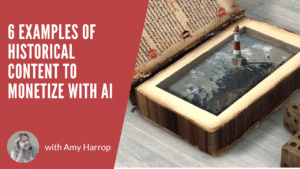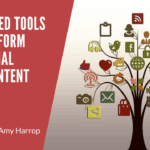 If you’ve been reading this blog for a while, you know I’m a big fan of public domain content. Items in the public domain are available for use without payment as long as you find ways to make them your own. That’s the fun part!
If you’ve been reading this blog for a while, you know I’m a big fan of public domain content. Items in the public domain are available for use without payment as long as you find ways to make them your own. That’s the fun part!
You may have noticed that historical content is very popular. When modern times are challenging, it’s common for people to become history buffs as they look for explanations of what’s happening in the present day.
What that means is that historical content is having a moment. Whether you’re interested in creating educational printables, wall art, or journals, history can inspire you and help you earn income at the same time.
Who’s Looking for Historical Content?
I told you there’s a big audience for historical content, but before I give you my best ideas for monetizing it using AI, let’s talk about who makes up that audience.
There are some sectors of the audience that might seem pretty obvious, such as educators, parents, and students. Educational printables are always in demand and history is one of many subjects that you can monetize.
The rest of the audience is composed of history buffs, non-fiction readers, hobbyists, and people who consider themselves to be lifelong learners. There will always be people who are eager to learn new things. History is a great subject for those people because… well, the breadth of human history is vast and there are always new events and topics to learn about.
So now, let’s talk about some of the types of historical content you can monetize with AI tools.
#1: Kid-Friendly Biographies
 Learning history in school may be a bit dry thanks to uninspired textbooks, but that doesn’t mean that kids hate history. In fact, many of them actually love history. They enjoy reading about historical figures, and thanks to AI, you can create biographies for kids, complete with public domain images, in just a few minutes.
Learning history in school may be a bit dry thanks to uninspired textbooks, but that doesn’t mean that kids hate history. In fact, many of them actually love history. They enjoy reading about historical figures, and thanks to AI, you can create biographies for kids, complete with public domain images, in just a few minutes.
Biographies may be printable or physical copies. An example of the former is this educational biography bundle I found on Etsy. It contains printable biographies of Clara Barton, Abraham Lincoln, and Susan B. Anthony, to name a few. The target audience for this product includes both parents and educators.
#2: Guides to Historical Events
 Another approach is to make historical content centered around famous events, which offers an opportunity to flesh out history with a deep dive around a significant date or period. Some examples might include:
Another approach is to make historical content centered around famous events, which offers an opportunity to flesh out history with a deep dive around a significant date or period. Some examples might include:
- The Fall of the Berlin Wall
- The Space Race
- The Passage of the 19th Amendment
- The Attack on Pearl Harbor
Any of these could be transformed into a guide and sold as a printable on Etsy or turned into a book to sell on Amazon.
#3: Podcast Scripts
 If you’re someone who loves podcasts, you probably already know that history podcasts are booming. There are tons of them available, including The Rest is History, Hardcore History, and Stuff You Missed in History Class.
If you’re someone who loves podcasts, you probably already know that history podcasts are booming. There are tons of them available, including The Rest is History, Hardcore History, and Stuff You Missed in History Class.
You can create podcast scripts with AI in just a few minutes. You could focus on a single historical figure, such as Rosa Parks or Jonas Salk. Alternatively, you could focus on an era such as The Civil War (or even individual battles) or the Civil Rights Movement. You could even do multiple episodes about the same thing. The Rest is History has aired more than a dozen episodes about the French Revolution, and you could do the same.
#4: History Trivia Sheets
 Fun historical facts are something many people love. They can teach us a lot by humanizing people from the past, making it easy to relate to them.
Fun historical facts are something many people love. They can teach us a lot by humanizing people from the past, making it easy to relate to them.
For example, did you know that Queen Elizabeth I owned more than 2,000 pairs of gloves, or that the world’s oldest known joke was written in cuneiform and was a fart joke? Little kids would love that last one!
#5: History Games
On a related note, why not think about creating a history game? Games may be played for fun or in the classroom (at home or at school) to help kids learn about history. Here are some potential ideas for history games.

- Black History Month bingo
- US History Trivia game
- History riddles
- History crossword puzzles and word searches
- Historical fiction trivia
The possibilities are infinite.
#6: Educational Printables
Anyone who’s been reading this blog for a while knows that I love educational printables. There’s a huge audience of parents and teachers of kids ranging from pre-K to high school, and you can create a wide array of products. For example:

- Flash cards
- Study guides
- Cheat sheets
- Games (as noted above)
- Workbooks
- Quizzes
Of course, any historical content you create with AI will need to be age appropriate, but that’s part of the fun. You can even create a series of guides on the same topic, with each one aimed at a different age group.
Tips to Use AI to Create and Monetize Historical Content
Now let’s get into how you can use AI to create historical content. Here are a few pointers.
- Use AI to find historical events, people, and niches that can be monetized. You’ll need to do some side-by-side research to make sure there’s an audience for what you create, but AI can streamline the process and save you tons of time.
- Create prompts to use as templates. For example, you might need a little trial and error to get the right prompt to create content for second graders, but once you’ve got the tone and content nailed, you can modify that same prompt to use many times.
- Implement AI design tools to quickly and easily create history printables, guides, and even wall art to sell in your online shop.
- Create short guides with AI and then use AI again to expand them into longer/more in-depth content. For example, you could take a short guide and transform it into a kids’ book, complete with illustrations.
I hope you get the idea and that you’re excited to get started creating your own historical content.
If you want to really automate and streamline the content creation process, check out Easy AI History, which has everything you need, including a custom GPT, to help you turn the past into profits!



